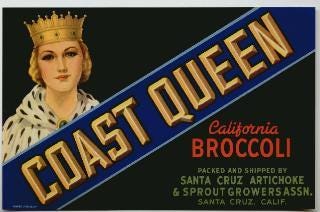Unpredictable Circumstances
#183: Unpredictable; Zines, Bay Area Italians, BrattyXBre, Abby Schleifer, Jeremy Collins, Collateral Damage, Dumbphones, Erik Winkowski, Mary Heilman; Louis Prima, DJ Mnty Frsh, Kruder & Dorfmeister
THEN
Unpredictable Circumstances
Although there are pieces missing in this narrative, I’m starting to get a feeling for the reasons my mother decided to seek employment at Birds Eye. As long time readers know, my father spent much of his life, from the early 1940s through the mid-1960s, working on ships.1 In early spring of 1954, he noted that his departure and embarkation schedules had gotten wonky. To explain these frustrating changes, he only cited “unpredictable circumstances” or used other mysterious phrases.
This was the period when Dad’s work assignments seemed to be shifting from working on transport ships during the Korean war, to his “Cold War” contracts with military ships involved in nuclear bomb testing in the Marshall Islands. The Castle Bravo test—the largest nuclear detonation ever conducted—took place in March 1954. I’m wondering if he would not have signed up for those jobs if he hadn’t been worried about the monthly mortgage payments. He was not able to reveal much information regarding his whereabouts nor where they were headed.2
Each letter from Dad during this period referred to “dough” that was on its way: checks for $150 to $300 dollars that he was sending to us to make sure the mortgage would be paid on time. Each letter described the logistics of mailing checks or—less often because of the risk—cash, along with forecasts of when the check might arrive in our mail box, or explanations for why they weren’t arriving on time.
Then, in his letter of May 18, 1954, Dad wrote that he hoped Mom was prepared for some disappointing news; he mentioned feeling “disgusted” with the situation he was about to recount:
Well, here it is. No pay-day and no draw either. So I cannot send you any dough. I don’t know what make[s] them3 do this. No explanation has been given. So I’ve none to give you. I only wish we have other recourse as far as our paying the bills is concern[ed]. Now it’s up to you to pray for a miracle so that we may be able to meet our obligation on time. Of course, I’m not very much worried about you and the kid would starve [sic], for you’re such a smart wife and mother. I only hope that you’re just kidding about you having no more cash around the house.
He included a P.S. that explained he had “tried to borrow left and right from amongst friends, but of no avail, for too, they are in the same fix as I.”
Yet somehow, all seemed to be back on track by June:
With the dough, as I’ve computed, including the insurance, you are entirely covered for the month of June. You’ll have enough left for your groceries too. So please, from now on, start budgeting your expenses. Let us save a few dollars here and there in order to build a cash reserve.
Still, that brief glitch in their funds must have made my parents feel how vulnerable we were.
Although the Birds Eye Cannery had already existed catty-corner across from our house as early as 1951, I don’t recall being aware of the buildings until my mother went to work there in 1956. An account by the Mobile Ranger on Facebook informed me that our neighborhood was known as a “vegetable packing hub” and that the cannery was built in 1951: “Under this roof, vegetables were packed, primarily by women, and sold with the labels: ‘Coast King,’ ‘Coast Queen,’ and ‘Coast Prince’."

I began to enjoy the presence of various babysitters as Mom started working at the cannery. First, there were the rather bored teenaged girls, always on the phone. When Mom started working the graveyard shift, I remember laying in my bed at night, missing her, although she was working just across the street. Oddly, I was comforted by the rumbling engines, metallic squeals, and clanking sounds of the Southern Pacific railroad cars as they pulled up beside the cannery every night, to receive their loads of crated vegetables.
Later, I would spend the night at our neighbor Jan’s house across the street. I was entertained by her children, Paul and Ruthie, who were constantly dreaming up plans for neighborhood plays and backyard carnivals. Jan was a single mom who drove a hot red Chevy convertible that she had christened “Cinnamon.” She would occasionally drive off with her rock ‘n’ roller boyfriend while we kids entertained ourselves.
After Jan, I stayed with Mrs. Campau, a kind woman with a missionary background who would occasionally invite the neighbor kids over to her house to view Christian films.
Mom didn’t say much about her job, but she did tell me once that her first days at the cannery were miserable. The noise and the sight and smell of all the vegetables whizzing by her as she sorted them made her nauseated, and once she nearly fainted and had to be sent to the nurse.
Eventually, though, she adjusted. And she made her first friends in Santa Cruz, who were immigrants like her: the many Italian American women who worked in the cannery. I would soon learn all their family names: the Canepas, the Stagnaros, the Castagnolas, the Bregantes, the Ghios, the Locatelli’s and more. One of her co-workers, Millie, was Italian and married to a Filipino. She and my mom became lifelong friends.
ART
Zines and the DIY/Punk Ethic
I’m old, so I missed out on the zine movement that some younger artists (and that includes people who are middle age) have been part of. However, I’m seeing these tiny xeroxed or self-printed books everywhere, lately, including online. In fact, Microcosm Publishing has declared 2025 to be “the year of zines.” So, coming late to this phenomenon, I’ve been reading and learning about them.
We have published and sold zines since 1996, and we’ve seen many waves of interest come and go. But we haven’t seen anything like the surge of zine sales that began on November 9, 2024. —Microcosm Publishing
As I consider this, I realize how invested people of my (older) generation seem to be in getting one’s work published by a major publishing house or journal, and/or getting one’s art featured in a major art gallery. Or heck—in galleries, period. But “Zinesters” seem to be bypassing all that.
Zines can be banned, but they’re too slippery to be stopped, too slight to be taken seriously, some too underground to even be found. They are decentralized, passed hand-to-hand, and there are no gatekeepers to corrupt or bottlenecks to plug. —Microcosm Publishing
Most zines are completely DIY, and there’s a mindset that goes with it, which stems from frustration with—if not animosity towards—systems of institutional patronage and capitalism, if I understand this correctly. Zines are self-published. They can be sold, and they can be given away; they can be glossy or xeroxed; they are often published on paper, but can also be available online. The point is, they are not dependent on institutions and traditional product marketing for their being. Their personal expression and ephemerality are what gives them value. The DIY and rebel aesthetic is intrinsic to the zine.
Zines have the ability to spread like dandelions seeds (I love dandelions), spreading without interference from corporate stakeholders or manipulative algorithms, just the wind guiding them where they must go, where they are most needed. I truly believe that zines are tools for resistance, truth-telling, and survival. —Jen Mayer
I don’t have a zine on hand to photograph for this issue, but Substack has a number of newsletters devoted to zines, where you can see images and learn more. Here are a few:
The Wee Sparrow Poetry Press Newsletter (anthologies and zines)
Zine Hug (micropress)
RABBIT HOLE
“How Bay Area Italians were Treated as Enemy Aliens During WWII,” by Pauline Bartolone.
BrattyXBre on banishing perfection in making your zine. Don’t make it perfect—just get it done!
“What the Sam Heck is a Zine?” By Abby Schleifer in Zine-O-Sphere, a section of her Abby Schleifer newsletter.
“The Elephant in the Room” or what artists and writers can and are doing in order to deal with “the doom of now,” by Jeremy Collins.
A short film about Santa Cruz’s “Collateral Damage” statue, by E.A. Chase. This monument is dedicated specifically to civilians—especially those in Hiroshima and Nagasaki—who have died in our wars. Buried at the base of the statue are hundreds of guns. Singer/songwriters Jackson Browne, Graham Nash, Bonnie Raitt, and Buffalo Springfield participated in the concert:
One of the best arguments (on video) that I’ve seen for switching to a “dumb phone”:
“The Written Image” by Erik Winkowski in his newsletter Paper Films.
Perhaps because I’m a Buddhist, I don’t often focus on artists who are influenced by Catholicism or Christianity. Mary Heilman pulls from her Catholic background (even from fantasies of martyrdom!) to fashion her experimental and iconic art:
I loved the whole Catholic culture as a kid. Growing up with those kinds of stories has carried on into my life, the way I think, and make up things now—and the fact that an object of art feels like an icon in the way icons were when I was little . . . and even talking about, like say, the drip as an icon. Color can be thought about in an iconographic way. I did do an painting based on the martyrdom of St. Sebastian. It’s called “Rosebud.”
SOUNDINGS
Italian American jazz man Louis Prima and vocalist Keely Smith perform “I’m in the Mood for Love”:
Local DJ MntyFrsh produces some beautiful sets. This is from Ascendance 4:
Gee, that cover looks familiar. Kruder & Dorfmeister perform tracks from their EP “G-Stoned.” They are currently touring and will be in California this fall:
My gratitude goes to everyone who reads Eulipion Outpost regularly, and especially to those who have subscribed or donated on my Ko-fi page to support my efforts.
My ongoing appreciation goes to the Mysterious M. for his excellent editing skills.
Website and blog: Jeanvengua1.wordpress.com
A Crooked Mile (a blog)
CommonwealthCafe (Filipino American & AAPI history and print culture)
Eulipion Outpost is a reader-supported publication. To receive new posts and support my work, consider becoming a free or paid subscriber.
More specifically, in ships’ galleys. He held various positions including messman, cook, and chief steward.
I wrote about this at length in Issue #151, “In the Land of the Sunrise.” If this ever gets into book form, I have a feeling that the nuclear testing period will be a lengthy chapter.
At the time he was working on the U.S.N.S. Gen. E.T. Collins, a General G. O. Squier-class transport ship for the U.S. Navy in World War II.






That cover took me aback. Just organized our vinyls and realized that my husband and I both have copies ofSimon & Garfunkel‘s Bookends.